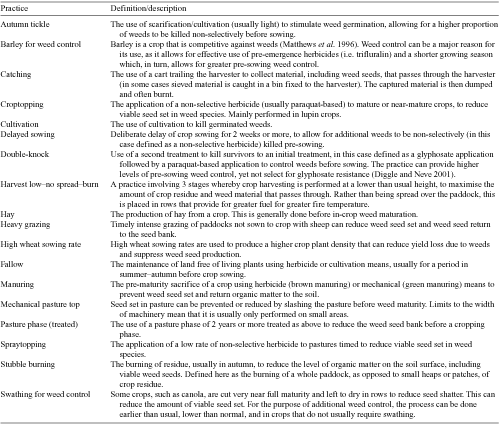Grain grower perceptions and use of integrated weed management
R. S. Llewellyn A B C , R. K. Lindner A , D. J. Pannell A and S. B. Powles BA School of Agricultural and Resource Economics, University of Western Australia, 35 Stirling Highway, Crawley, WA 6009, Australia.
B Western Australian Herbicide Resistance Initiative, Faculty of Natural and Agricultural Sciences, University of Western Australia, 35 Stirling Highway, Crawley, WA 6009, Australia.
C Corresponding author. Email: rllewell@agric.uwa.edu.au
Australian Journal of Experimental Agriculture 44(10) 993-1001 https://doi.org/10.1071/EA03115
Submitted: 6 June 2003 Accepted: 5 March 2004 Published: 25 November 2004
Abstract
Greater adoption of integrated weed management, to reduce herbicide reliance, is an objective of many research and extension programmes. In Australian grain-growing regions, integrated weed management is particularly important for the management of herbicide resistance in weeds. In this study, survey data from personal interviews with 132 Western Australian grain growers are used to characterise the use and perceptions of integrated weed management practices. The main objective was to identify opportunities for improved weed management decision making, through targeted research and extension. The extent to which integrated weed management practices are used on individual farms was measured. Perceptions of the efficacy and reliability of various weed management practices were elicited for control of annual ryegrass (Lolium rigidum Gaud.), along with perceptions of the economic value of integrated weed management practices relative to selective herbicides. All growers were shown to be using several integrated weed management practices, although the use of some practices was strongly associated with the presence of a herbicide-resistant weed population. In general, both users and non-users were found to have high levels of awareness of integrated weed management practices and their weed control efficacy. Herbicide-based practices were perceived to be the most cost-effective. Opportunities for greater adoption of integrated weed management practices, to conserve the existing herbicide resource, exist where practices can be shown to offer greater shorter-term economic value, not necessarily just in terms of weed control, but to the broader farming system.
Acknowledgments
Funding for this research was provided by the Grains Research and Development Corporation, through funding of the Western Australian Herbicide Resistance Initiative (WAHRI), with additional support to Rick Llewellyn from the CRC for Australian Weed Management. We thank Mechelle Owen and Ryan Duane for their contribution to the data collection and Michael Burton for advice on data analysis. The authors are also grateful for the valuable comments from referees.
Adesina AA, Baidu-Forson JB
(1995) Farmers perceptions and adoption of new agricultural technology: evidence from analysis in Burkina Faso and Guinea, West Africa. Agricultural Economics 13, 1–9.
| Crossref | GoogleScholarGoogle Scholar |
(verified 10 October 2004).
Llewellyn RS,
Lindner RK,
Pannell DJ, Powles SB
(2002) Resistance and the herbicide resource: perceptions of Western Australian grain growers. Crop Protection (Guildford, Surrey) 21, 1067–1075.
| Crossref | GoogleScholarGoogle Scholar |

Llewellyn RS, Powles SB
(2001) High levels of herbicide resistance in rigid ryegrass (Lolium rigidum) in the wheatbelt of Western Australia. Weed Technology 15, 242–248.

McDonald DG, Glynn CJ
(1994) Difficulties in measuring adoption of Apple IPM: a case study. Agriculture Ecosystems and Environment 48, 219–230.
| Crossref | GoogleScholarGoogle Scholar |

Orson JH
(1999) The cost to the farmer of herbicide resistance. Weed Technology 13, 607–611.

Pannell DJ
(1999) Social and economic challenges to the development of complex farming systems. Agroforestry Systems 45, 395–411.
| Crossref | GoogleScholarGoogle Scholar |

Powles S,
Preston C,
Bryan I, Jutsum A
(1997) Herbicide resistance: impact and management. Advances in Agronomy 58, 57–93.

Swanton C, Weise S
(1991) Integrated weed management: the rationale and approach. Weed Technology 5, 657–663.

Walsh MJ,
Duane RD, Powles SB
(2001) High frequency of chlorsulfuron resistant wild radish (Raphanus raphanistrum) populations across the Western Australian wheatbelt. Weed Technology 15, 199–203.

Wearing C
(1988) Evaluating the IPM implementation process. Annual Review of Entomology 33, 17–38.
| Crossref | GoogleScholarGoogle Scholar |

Wossink G,
de Buck A,
van Niejenhuis J, Haverkamp H
(1997) Farmer perceptions of weed control techniques in sugarbeet. Agricultural Systems 55, 409–423.
| Crossref | GoogleScholarGoogle Scholar |


|


